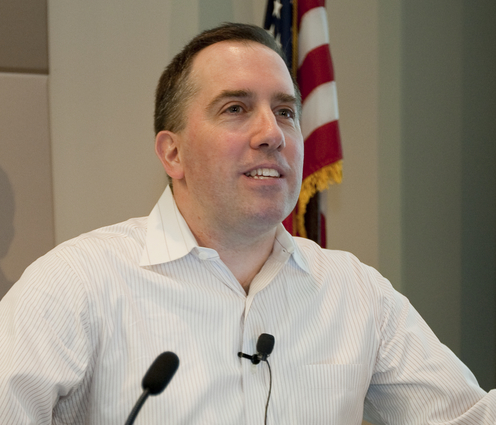Predictions compute for future of mobile devices
 (Download Image)
Jon Koomey
(Download Image)
Jon Koomey
We can expect ever more amazing mobile computing devices in coming years. This week, Jon Koomey , author, researcher and consulting professor at Stanford University, discussed the reasons for this prediction during a noon presentation in the Bldg. 543 auditorium.
Koomey's talk, "Assessing Trends in the Electrical Efficiency of Computation Over Time," one in a series of Living Well -- Living Green seminars, highlighted his research that yields a key result: computations per kilowatt-hour of electricity have doubled every 1.6 years since the 1940s.
The former Lawrence Berkeley Lab group leader initially based his work on costs, energy and performance trends but then followed from researcher William Nordhaus's work and focused analyzing energy and performance. Using measured power statistics either published or from archival or recent computers, the data relates to a wide range of computers, from PCs to mainframes.
Koomey said that power measurements were conducted at Microsoft's computer archives, Lawrence Berkeley National Laboratory, computer history buff Erik Klein's computer archives, and even in the basement of Koomey's in-laws (a fact that drew laughter from the audience). In addition, he consulted the Computer History Museum's Websites and discussions forums.
Results of analysis showed that computations per kilowatt-hour doubled every 1.57 years over the entire analysis period, a rate of improvement only slightly slower than that for PCs, which doubled every 1.49 years from 1981 to 2009.
What is noticeably evident, Koomey said, is the "big jump from (vacuum) tubes to transistors."
Koomey's work, funded through Intel and Microsoft, confirms that the years 1959, 1960 and 1961 -- a time when transistorized computers came to market in large numbers -- showed about two orders of magnitude difference between the most and least electricity intensive computers.
The current trend is toward an increase in mobile devices, which rely on batteries. "That's the big result," Koomey said. "Laptop computers have become important and have exceeded desktop sales."
Koomey noted that physicist Richard Feynman in 1985 analyzed the electricity needed for computers and estimated that there was a factor of 1011 improvement that was theoretically possible compared to computer technology at that time. Since then, performance per kilowatt hour for computer systems has improved, but, as he explained "there is still a long way to go theoretically." Assuming trends in chips continue for the next five to 10 years, significant improvements will occur.
For Koomey, future work includes collecting data on more laptops, as well as PDAs and game consoles; investigating how trends differ in mainframes, PCs, laptops and servers; determining if power and performance trends for low-end chips are different than for the most sophisticated CPUs; and looking at real-world performance vs. benchmarks.
For now, Koomey says we can look forward to "more and more battery devices," as well as more cell phones and sensor networks.
Koomey latest book, " Turning Numbers into Knowledge: Mastering the Art of Problem Solving ," published in April 2008, offers a guide to better problem solving for managers and employees to be more effective in life and work.
Koomey's talk was hosted by LLNL's Western Region Energy Analysis Program and Work-Life's Living Well -- Living Green Program. For a copy of Koomey's viewgraphs from his presentation, go here .




